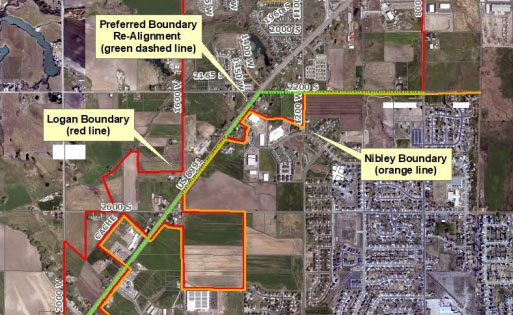
A proposal by Logan officials to realign the city’s southern boundary with Nibley as shown here was informally tabled Thursday in favor of establishing a new framework for future discussions between the neighboring municipalities.
NIBLEY – Meeting jointly Thursday, the city councils of Logan and Nibley agreed to politely disagree about proposed boundary revisions, but ultimately established a framework for future discussions.
Logan council members came to the meeting at Nibley City Hall with a proposal to simplify a patchwork quilt of current boundary lines between the municipalities that twist and turn on both sides of US Hwy. 89/91. Their proposal was to realign the boundary line to run straight north from 3000 South down the middle of US Hwy. 89/91 until it turns onto 2200 South and runs east until 800 West.
Their counterparts from Nibley had a more ambitious agenda in mind, however. In addition to alternative boundary proposals, they wanted to discuss the creation of a permanent boundary commission along with longstanding issues of highway alignment and the impact of high-density development.
Speaking for Nibley, council member Kathryn Beus outlined two alternative proposals. The first of those proposals would use 2200 South as the boundary on both sides of US Hwy. 89/91. Another alternative would use 800 West as the boundary between the cities.
Both of those alternatives would address one of Nibley’s major concerns, the disproportionate impact of high-density housing developments along Logan’s southern city limits. Beus said such developments would have social and recreational impacts on all of Nibley.
Nibley officials said that coordinating planning and zoning decisions to avoid those sort of cross-border impacts would be one of the benefits of their proposed boundary commission.
Another bone of contention between the neighboring municipalities is which of them would ultimately inherit jurisdiction over Ted’s Service station at 3180 S. US Hwy. 89/91.
Nibley’s plan called for the Border Commission working group to be a permanent entity composed of two council members from each city. Their mandate would be to facilitate discussion of issues including improved communication, road/highway alignment, development along city borders, cross-border impacts and service concerns.
Boundary issues have been simmering between Logan and Nibley for more than half-a-decade, according to Logan City Attorney Kimber Housley.
Logan council member Jeannie Simmonds admitted to unintentionally derailing the last attempt at consensus on those issues during the previous tenure of Mayor Craig Petersen.
Nibley has a population of about 7,500 residents, of which only about 2,000 are old enough to drive, quipped Mayor Shaun Dustin. The city has a land area of about 5 square miles. By comparison, Logan has a population of more than 48,000 residents and a land area of 18 square miles.
Logan Mayor Daines continued to push for at least a tentative agreement on the boundary realignment for much of the meeting, until Logan council member Jess Bradfield recognized that only incremental progress on that issue was possible.
With that in mind, he proposed a joint resolution to create a framework to facilitate future negotiations between the two municipalities.
That resolution, which was unanimously approved by both city councils, will establish an ad hoc group of two council members from each city within 30 days. The members of that working group will serve as liaisons to explore border options, examine trigger points for future discussions, improve inter-city communication and foster mutual goodwill.
The members of both city councils agreed that the issue of Ted’s Service station should be the working group’s first priority as a test case.

